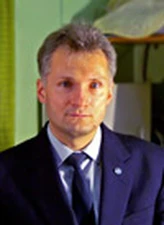Mikhail Aleksandrovich Nosov

The 2005 Plinius Medal is awarded to Mikhail Aleksandrovich Nosov for discovering the sea surface temperature anomalies above underwater earthquakes, and for estimating the contribution of nonlinear phenomena in tsunami generation.
Dr. Mikhail A. Nosov graduated in Physics from the M.V.Lomonosov Moscow State University, where he took his Ph.D. in 1991 and his Dr.Sc. (highest degree in Russia) in Physics and Mathematics in 2004. He is presently Senior Researcher at the Physics Faculty of the M.V.Lomonosov Moscow State University. His main research activities center on tsunami, with a specific focus on dynamic processes in the oceans induced by strong sea-bottom earthquakes. His research interests involve: i) tsunami generation mechanisms considering water compressibility and nonlinearity, ii) the study of sea surface temperature and chlorophyll concentration anomalies above submarine earthquakes, and iii) physical mechanisms of seismogenic upwelling. To conduct these researches, he uses a variety of methods, including mathematical modeling, laboratory simulations, in-situ data acquisition and processing, and field investigations.
He was the first to observe sea surface temperature (SST) anomalies and chlorophyll concentration anomalies in the regions of strong submarine earthquakes, through a complex analysis of satellite data and the catalog of earthquakes. Based on the results of laboratory and numerical modeling, he explained the phenomena as an increase in the vertical turbulent exchange in the ocean, due to intensive seismic movements of the ocean floor. Through analytical and numerical modeling of the generation of wave motions in a layer of compressible and incompressible heavy fluid by bottom displacements, he revealed a difference in the behavior of a compressible and an incompressible ocean, showing that the problem of tsunami excitement by submarine earthquakes must be considered in the framework of the model of a compressible fluid. Using analytical and numerical methods, he has shown that a tsunami can be generated by nonlinear energy transfer from the “fast” elastic or forced oscillation of a water layer caused by submarine earthquake to long gravitational waves. He was the first scientist in Russia to carry out complex laboratory experiments and mathematical modeling to reveal tsunami parameters as a function of time-space history of sea bottom motions. He invented an original infrared wave gauge allowing to measure water waves with sub-millimeter amplitude.
He is the author or co-author of nearly 50 papers, and he is the author of the book “An Introduction to the Theory of Turbulence” (in Russian). His was awarded the State Scholarship, the Award of Physics Faculty of M.V.Lomonosov Moscow State University, the Moscow State University Prize, and the Award of ACADEMIAE EUROPEAE for young scientists from former Soviet Union. He is Principal Investigator of research projects supported by the Russian Foundation for Basic Research. As co-convener and UNESCO contractor, he has organised the International Workshop on “Local Tsunami Warning and Mitigation” (2002). He is an energetic participant to the EGS and EGU meetings.
